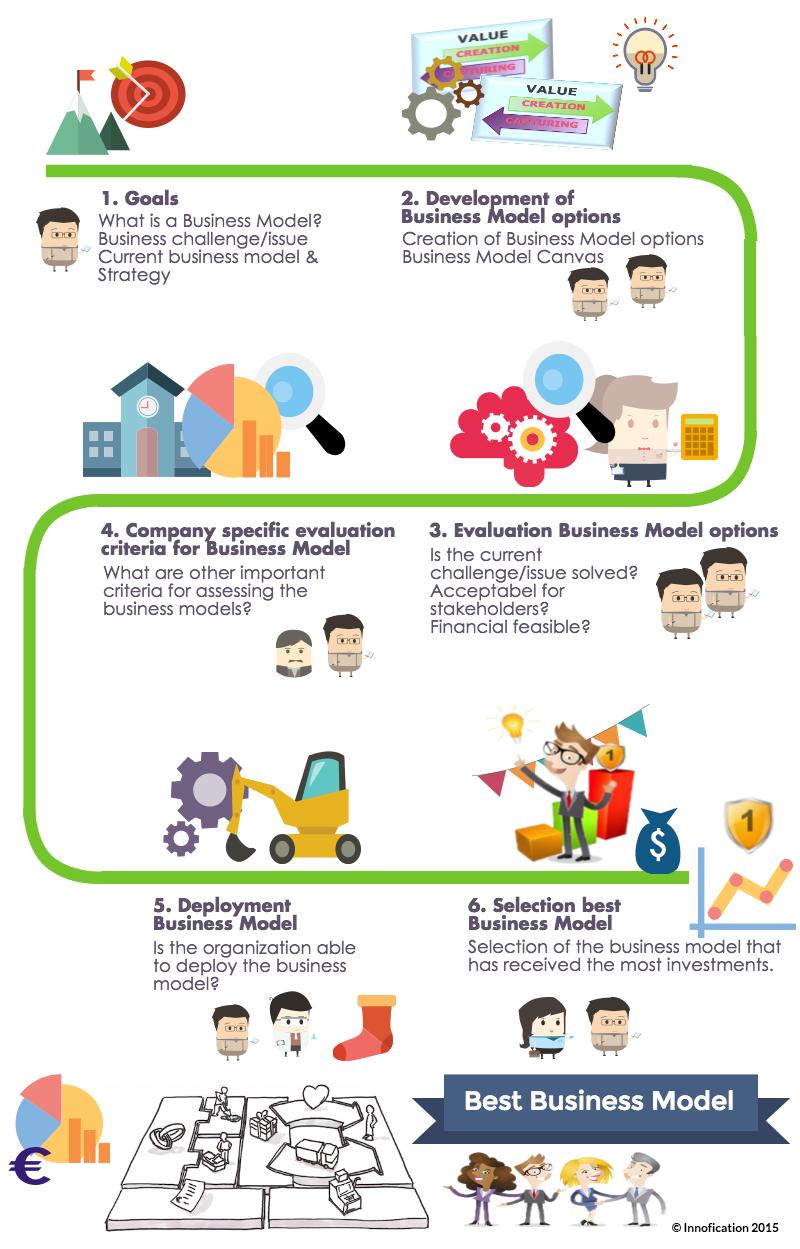
Challenge
Organisations are often well aware that the business in which they operate can be very competitive and earnings are declining. Do "things" better has its limitations, where there comes a time where "things" should be done differently. Organisations should search for new business models that create new customer value and enable new revenue streams.
Often, there are some ideas about business models, made in a one-day workshop, but not embedded within the organization. In addition, it is not seriously developed and tested for its feasibility.
Purpose
Select, develop and deploy the best business model within the organisation based on the conception/conviction of different stakeholders/players for different business models.
Approach
The starting point for developing a new business model is still the mission, vision of the organization and their goals. This outlines the scope of the game which is played.
It is also important that there is a good understanding what the current business model is. Perhaps, the current business model need to be completely abandoned. But you can most often not ignore your existing business model during implementation of a new business model. How does the roadmap for the new business model look like or will it be a bing bang scenario?
Last but not least, players should be aware what a business model is to avoid misunderstandings. The business model canvas (BMC) of A. Osterwalder is used here as a common communication tool for a business model. In the knowledgebase of the game information is present about business models.
By the players, perhaps in a team, a business model option (or even several) is
elaborated and shared the platform.
In each round a player (with his team) must answer specific questions about their business model. All players in the game have a budget available per round, which they can invest into the answers of the questions and complement the investment with comments.
In this way, players receive constructive feedback and values are assigned to the business models.
The business model, which has received the most investments, is the best/winning business model that can be deployed by the organisation. In addition, the winning business model has the most support within the organisation.
In the first round, the business models are assessed on the basis of common criteria (questions).
Hierbij worden de volgende criteria gehanteerd:
Is the objective achieved
FOETSJE criteria
Acceptable for stakeholders
The individual components of the business model are deliberately not been reviewed, but we look at the business model as a whole (holistic). For example, can a strong component compensate a weak component in a business model?
In the second round the different business models are assessed on the basis of business or business-specific criteria. In a bank, for instance risk and compliance will play an important role and in the manufacturing industry ecological criteria are more important.
In the next round the various business model options will be assessed based on its deployment capabilities. What are the risks to implement the business model? Does the business model fit the culture of the organisation? Does the organisation have the competences to implement the business model? How can we measure the performance of the new business model? Are there any conflicts with the existing business model or will the existing business model be phased out?
In the next round is a clear choice for the business model which has received the most investments received / collected and thus enjoys the most support from the stakeholders.
In the next round the winning business model, which has received the most investments, will be selected. It has the most support of stakeholders.
It is important that customers who are going to play the Business Model Innovation Challenge express their commitment to the actual winning business model. Otherwise could result in brand damage. The game sets high expectations from players.
The Business Model Innovation Challenge is a transparent serious game where all players / participants has access to all information such as investments, budgets of all participants etc.
The serious game has the capability that several players have different investment budgets per round based on for example position and / or knowledge. The competences of a marketer, business development manager, innovation manager will probably be more valuable in the first and second round. Project, program, change management and business line managers will likely have more competences during the round where deployment of the the business models has the emphasis.
Results
Select the best/winning business model for the organisation, which is also supported by the stakeholders.
Understanding different business models that are possible, including alternatives
Understanding the winning business model in terms of:
Success probability regarding value creation and related earning model.
Implementation of the business model, the timelines and project risks.
Understanding the change process that the organisation must undergo.
Customization
The Business Model Innovation Challenge can fully customized based on your business needs.
